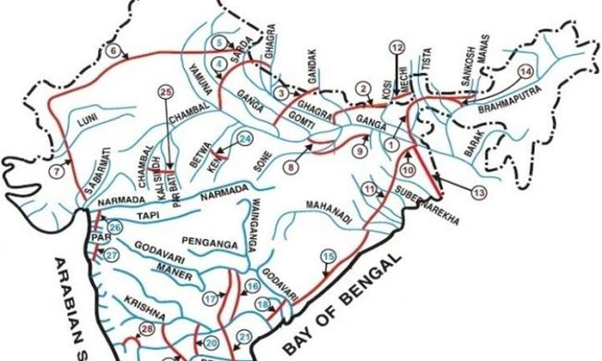

|
Overview
|
Context
Environmental groups in Karnataka have criticised the project to link the Bedti and Varada rivers in Karnataka, calling it ‘unscientific’ and a ‘waste of public money’.
- This issue has aroused questions on several river interlinking projects across the country, and brought them under scrutiny.
Background
Background
- The initial plan to interlink India’s rivers came in 1858 from a British irrigation engineer, Sir Arthur Thomas Cotton.
- In 2014, the Ken-Betwa River Linking Project got Cabinet approval.
- However, the project is yet to take off because of the opposition faced by the government chiefly from environmentalists.
About
What is Inter-linking of rivers?
- River Linkingis a project of linking two or more rivers by creating a network of manually created reservoirs and canals, and providing land areas that otherwise does not have river water access and reducing the flow of water to sea using this means.
- It is based on the assumptions that surplus water in some rivers can be diverted to deficit-river by creating a network of canals to interconnect the rivers.
- Uses:
- For Irrigation purposes
- flood control in the region
- for Livelihood needs of locals
- Building Dams for water conservation
What was the issue raised under ‘Bedti- Varada river project’?
- The issue highlighted the government’s planning of interlinking two opposite directional flowing rivers with each other that lack sufficient source of water in them.
- The investigating group has made allegation on government for using river interlinking project for their benefit and corruption, making profit to contractors, builders and wasting valuable resources in the region.
|
National River Linking Project (NRLP)
|

What is the vision for interlinking river projects in India?
- As per the government, the project is needed to meet increasing water requirement in the country.
- Core idea: Overall, the NRLP envisions the transfer of waterfrom water ‘surplus’ basins (perennial Himalayan rivers) where there is flooding to water ‘deficit’ basins (rain-fed peninsular rivers) where there is drought/scarcity, through inter-basin water transfer projects, For example- The Ken-Betwa Linking Project.

Are there previous examples of river-linking in India?
- In the past, several river linking projects have been taken up.
- Under the Periyar Project, transfer of water from Periyar basin to Vaigai basin was envisaged. It was commissioned in 1895.
- Similarly, other projects such as Parambikulam Aliyar, Kurnool Cudappah Canal, Telugu Ganga Project, and Ravi-Beas-Sutlej were undertaken.
- Godavari River has also been formally interlinked with the Krishna River at Ibrahimpatnam (near Vijayawada) in Andhra Pradesh in September 2015.
What are the advantages of interlinking Rivers?
- Reduce dependence on Rainfall
- Used for Navigation
- For Agriculture purposes
- Power Generation
- Other benefits:
- Water supply: The project envisages a supply of clean drinking water amounting to 90 billion cubic meters. It can resolve the issue of drinking water scarcity in India.
- Similarly, interlinking of rivers has the potential to provide 64.8 billion cubic meter of water for industrial use.
- Apart from that, interlinking can help the survival of fisheries; protect wildlife in the summer monthsdue to water scarcity. It can also reduce forest fires occurring in India due to climatic conditions.
- India can also explore an additional line of defencein the form of waterline defence.
What are the challenges associated with River-Interlinking?
Despite the many benefits that are associated with the river interlinking project, the project is yet to take off because of the many hurdles it is facing. Some of the challenges in this regard are as follows:
- Project feasibility: There is a requirement of huge structures which requires a great engineering capacity. So, the cost and manpower requirement is immense.
- Environmental impact: The huge project will alter entire ecosystems. The wildlife, flora and fauna of the river systems will suffer because of such displacements and modifications.
- Many national parks and sanctuaries fall within the river systems.
- Can lead to displacement: Building dams and reservoirs will cause the displacement of a lot of people. This will cause a lot of agony for a lot of people.
- They will have to be rehabilitated and adequately compensated.
- Myth of controlling floods: There have been instances where big dams like Hirakud Dam, Damodar Dam, etc. have brought flooding to Odisha, West Bengal, etc.
- Inter-state disputes: River water has no boundary and flows across different states. Hence River water remains a matter of dispute between the states normally.
- Interlinking of those already disputed rivers can further worsen the situation between the states.
- International disputes: In the Himalayan component of the project, the effect of building dams and interlinking rivers will have an effect on the neighbouring countries. This will have to be factored in while implementing the project.
- Bangladesh has opposed the transfer of water from the Brahmaputra to the Ganga.
|
PRACTICE QUESTION Q1. River linking projects for the country are a great opportunity to address the water issues arising out of climate change. Q2. Do you think river interlinking is the most suitable way forward for water management in India? Critically examine. |

